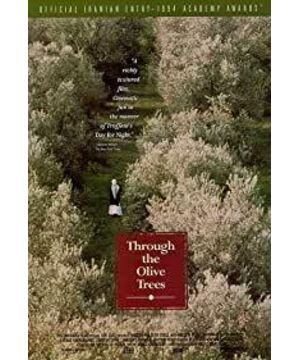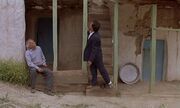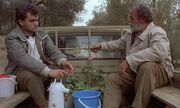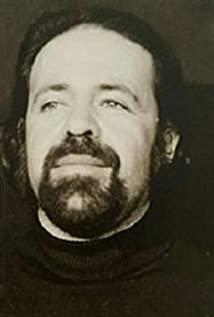For a long time, people have been accustomed to the image of a dove with an olive branch as a symbol of "peace", but they may have overlooked the original meaning of this image, which is "life", especially the new "life" obtained after experiencing the catastrophe. This image comes from the story of "Noah's Ark" recorded in the "Bible": At the beginning, Jehovah regretted creating man on the earth, and felt sad for the sins committed by mankind. He decided to wipe out all the man and all animals he created and end this The sinful world. However, he was reluctant to destroy all of his creations, so he decided to keep the Noah family, who had always been safe and secure, to continue human life, hoping that they could build a happy new world. Noah built an ark according to God's will, and led the whole family and all kinds of birds and beasts, a male and a female, on the ark before the flood. Soon, 40 consecutive days and nights of heavy rain flooded the highest mountain on the earth. All the creatures on the ground were not spared, except for Noah's Ark floating on the endless water. The flood receded very slowly, and only a mountain top appeared on the water after ten months. A few days later, Noah released a dove to test whether he could find land for humans and animals to inhabit. In the evening the pigeon flew back with an olive branch in its mouth, which meant that land was exposed somewhere.
For the Chinese translation of the title of the film that Abbas completed in 1994, the popular translation method in China is "Through the Olive Trees", which is based on the English "Through the Olive Trees" and the French "Au travers des oliviers". Become. However, this translated name is not very accurate, because according to Abbas, the original Persian film name of this film ("Zire Darahtane Zeyton" in Spanish) means "under the olive tree". The original scene of peace and tranquility was rendered dynamic by European and American people who were both active and quiet, and was turned into a "lover under the olive tree" by translators from Hong Kong and Taiwan who have always liked acting.
None of the above translations are wrong, at least they are related to the olive tree, but this article still tends to choose "Under the olive tree" as the Chinese translation, not only because it is more in line with the original meaning of Persian, but also because it embodies Abbas The homage to Italian neorealism reminds people of the not-so-famous film "No Peace under the Olive Tree" more than half a century ago. There is no peace under Santis’ olive tree, but life under Abbas’s olive tree is endless. We don't know if Abbas named this film "Under the Olive Tree" or not was inspired by Santis's film, but the influence of Italian neorealism films on him is real. Speaking of the issue of title translation of foreign films, Hong Kong and Taiwan have overlaps and differences. Taking the other two films in the Abbas trilogy as an example, Hong Kong people translated "Where is my friend's house" into " "Tread through iron shoes and find nowhere to find", and translate "Life Continues" as "spring breeze blows and regenerates", which makes it difficult for people to turn into Persian, English or French. However, the Taiwanese translation of "Where is My Friend's House" and "The Long Flow of Life" are both in line with the original meaning, and not as straightforward as the mainland translation.
"Under the Olive Tree" is the third part of the Abbas movie trilogy. Its theme is derived from "Life Continues", and "Life Continues" directly comes from "Where is My Friend's House". In May 1994, during Abbas’s participation in the Cannes Film Festival, someone asked: "You probably never thought about making a trilogy, but the theme of the third film "Under the Olive Tree" is from the second film "Life in "Continue" was born?" Abbas replied: "In the past two weeks, people have often asked me the same question. I really don't know how to answer. I tried various answers, but none of them Really. I just found the answer in the last two days: the emotional connection between me and the characters in these films forced me to continue filming with them. Between shooting "Where is my friend's house" and "Life Continues" The same thing happened."
The four-minute scene in Abbas’s "Life Continues" shows the daily life of a newlywed couple. This is one of Abbas’s favorite scenes, so that it can be reproduced in "Under the Olive Tree". And the idea of filming "Under the Olive Tree" came directly from the director's attention to the new couple. On the last day of filming "Life Continues", Abbas came to the olive grove for a walk, and suddenly thought of a couple strolling here. He felt that this should be a good subject, until one day a book titled "The Movie" When he saw a movie still in his magazine, he remembered what he thought about in the olive grove that day. "In fact, I have forgotten the details, but I spoke very sincerely to the actress who played the bride in the stills. Usually I don't talk to the actress so much, so I asked myself: Why did I talk to her so seriously at the time Later, I remembered that there was a conflict between that girl and the boy who played the husband. The boy wanted to marry her, but she was a little unwilling." So far, the outline of "Under the Olive Tree" has roughly taken shape.
"Under the Olive Tree" continues the exploration of the theme of life in "Life Continues", and at the same time plays an unforgettable love ode. The love mentioned here not only refers to the love of the protagonist in the film (that is, Hussein's love for Tahli), but also refers to the love of the film's owners for the film. A film crew came to the earthquake-stricken area to shoot. The actor selected as the leading actor stuttered due to excessive tension, causing the film crew to stop filming. The director temporarily decided to ask Hussein, a young man in the crew, to save the scene. Coincidentally, Taheri, who played the heroine, was reluctant to act with Hussein, because Hussein wanted to marry her for a long time, but she was rejected by her, especially her family, because of her misconduct. Later, out of her love for the film (perhaps due to the intentional matchup between the director and the scene), she finally agreed to play the newlyweds with Hussein. Can the lovers who play husband and wife in the movie dream come true in real life? "Under the Olive Tree" is another "movie that asks questions", and the questions raised in this film echo in the sky above the earthquake ruins, in the valley covered by olive groves, and in the hearts of the audience in the theater. For Hussein, the question is "Where is my fiancée's house?" For Taheri it is "Where is my fiancé's house?" For Abbas, it is "What is the value of the master of film?" "Like the "Close-up" and "Life Continues" a few years ago, Abbas continues to question the value of the film master in this film, as is the problem in all his previous films, the "Under the Olive Tree" There are no answers to these questions.
In any case, the long scene at the end of the film—the paragraph shot is unforgettable, giving people a sense of reality and illusion. When talking about the conception of this scene, Abbas said that since there is always an insurmountable distinction between the young couple, there is no reason for the girl to give a positive answer to the boy’s request. Moreover, the girl’s parents were alive. Has rejected this marriage. Abbas said: "In a country like ours, the dead are powerful, and the decision they made before they die cannot be overturned." At first, Abbas had decided to let them go through the olive grove and never come back, but In the finished film, people see them gradually turning into two white spots, just like two small white flowers in a green valley. This dreamlike ending, which leaves people with good hope, was gradually conceived by Abbas in the process of repeated shooting.
In order to shoot this scene well, Abbas watched the mountain for 20 days so as to wait for the best light to capture the most beautiful moment. In the process of enjoying the fascinating scenery, Abbas gradually entered a certain state of meditation. Nature seems to have given him this revelation: Sometimes it is possible to forget social problems. Therefore, he tried to temporarily forget certain traditions and added some dreamy colors to this scene, hoping and hinting that the heroine could finally give the young man an affirmative answer. This is an excellent opportunity for Abbas to temporarily escape from reality with the help of the Dream Road. Movies can sometimes make him forget reality for the sake of dreams and even break it. "My last film "Life Continues" was completely a dream for me. In this film, a 4-minute scene reappears in "Under the Olive Tree", which shows that it is a dream. However, The dreams we see in "Under the Olive Tree" have a certain reality. In "Life Continues", what appears as a'dream' actually faces the camera. I think dreams are very close to reality. Dreams can help us escape from reality. Movies are derived from dreams. They can help us create dreams and make dreams possible."
"Under the Olive Tree" is an ode to love and movies, as well as a movie about movies. This film breaks the boundaries between the inside and outside of the screen. The characters come and go freely before and after the camera, and the structure is very complicated. When it comes to the complexity of the film structure, people often think of Fellini's "Eight and a half". French film theorist Christian Metz believes that this film has a special layer structure. In a sense, the structure of "Under the Olive Tree" as the last part of the Abbas trilogy is like a maze, perhaps even more confusing than Fellini's film. Through this complex structure, we have seen at least three overlapping films: this film, film in film, film in film...
Abbas’s trilogy is not a series in the ordinary sense, and the American film critic Godfrey Chesil even thinks that it is wrong to call them a series. To be precise, Abbas’s entire project of shooting these films should be likened to a stone tablet that has been inscribed several times. This stone tablet has been inscribed with articles before being erased and inscribed with new articles. When people read the newly engraved articles, the previously engraved articles are vaguely visible. Each of Abbas’s new films is not a complete continuation of the previous film, but is derived from the previous film. It is a questioning, correction and reflection on the previous film. "The rewritten stone stele" is "palimpsest" in English, which means "(after scraping off the original text) the rewritten stone stele". Freud used this term when talking about the memory mechanism of human beings. The memory of the event is incomplete. It has never been fully expressed. It is just fragments of the past, but they are all related to the past. People's performance of past events can only be achieved through the existence of "reverberations between events". Only memory can get close to the truth of the event.
People will have a lot of questions when watching "Under the Olive Tree". For example, this film is about the process of a film crew shooting "Life Continues" (at least on the surface), but the film crew in the film has the title "Under the Olive Tree" on its clapperboard. ". During the shooting, Abbas’s crew also reminded him that this was a mistake and that the title of "Life Continues" should be written on the scene board. Abbas explained that this film is a reconstruction of reality, not reality itself. To him, it seemed more correct to choose the title of the film he was shooting. In fact, "The two films are so closely intertwined that I can't distinguish them from each other. There is no need to try to understand this question." We didn't really understand what was going on during the shooting process. This is a film about a film that was shot in the past, which was how we made it at the time. The past and the present blend together." A similar situation is that the filming time and the story of the film in "Under the Olive Tree" were both in 1991. However, shortly after the film began, the voice from the radio said that people were in May 1993. In this regard, Abbas explained: "We reconstructed the scene that people thought occurred a year after the earthquake, but the actual shooting time of the film in the film coincides with the actual shooting date of the film we are shooting. It’s now. In fact, this explanation is the same as our explanation of the clapperboard.”
It is also puzzling that everyone in "Under the Olive Tree" is acting as himself, but why does Abbas not appear as a director in the film, but let an actor act as his substitute? If he insists not to appear in the film, it's fine, but why did he show his face behind the camera in the film again? In fact, it’s not that Abbas didn’t think about playing himself by himself. When shooting "Life Continues", he thought of appearing as the director of "Where Is My Friend's House" in this film, but he did not do so in the end. He also did not appear as a director in "Under the Olive Tree", perhaps because he wanted to add some illusions to this true story, or because he felt that this would distract as a director, or from a technical perspective, if he was in In this film, you have to act as the director of these three films at the same time, which will cause more confusion. What is it for? I am afraid it is difficult for Abbas himself to explain clearly.
British film researcher Laura Mulvey uses the "uncertainty principle" to summarize Abbas's film aesthetics. When talking about the feeling of watching "Under the Olive Tree" for the first time, he said: "I felt a sudden and intuitive shock. At that time, I felt that the movie can still be amazing, beautiful or sensible. As a movie Theorists, I think Kiarostami’s films are closer to avant-garde films than art films. Its narrative, photography, and way of dealing with film reality make it easier to associate them with film theory, but It is also opposed to any aesthetic or analytical framework that people expect. My intellectual and aesthetic uncertainty is aroused by a strong curiosity." He believes that it was born in the 1970s and then flourished. Temporary film theories (mainly feminism and psychoanalysis in Mulvey's view) seemed to have reached a time when it was urgently needed to be updated in the 1990s, and new films were also needed to make the generation of new ideas possible. The appearance of the Abbas movie brought the theorists back to André Bazin’s question: "What is a movie?"
This issue will be debated every ten years, and every dispute will not have a clear result, but it will continue to be debated in the future, and the cycle will continue to infinite. Is the film invented on the basis of the "principle of visual deception" a "restoration of material reality"? Is it "the asymptote of reality"? Is it "image in the mirror"? Even if the movie is reality, what is reality? Abbas probably won’t be interested in such questions, but he reminds people to pay attention: “Never forget that we are watching a film. Even at a moment that seems very real, I want to project the picture on the screen. The vocal cords on the side flicker constantly, in order to remind the audience not to forget that what they are watching is not reality but a movie, that is, the movie we shoot based on reality. I have strengthened this in several new movies. The practice will be further strengthened in the future."
Although "Under the Olive Tree" drew a successful conclusion to the "Korgel" trilogy, the theoretical thinking it triggered may have just begun. Will Abbas still come here to make movies? Abbas said: "Of course I do, but at the same time I think I should resist this temptation. However, I still decided to shoot there for another ten years, in order to re-shoot the life of the couple in "Under the Olive Tree". Where will they develop." Will always shooting in the same place limit the film? Abbas believes that making a movie is like digging treasures like digging wells. Only by keeping a place and digging a well, can you dig treasures and dig out spring water. It's ridiculous to dig everywhere! Due to the devastating blow in the 1990 earthquake in Kegel Village, almost all the houses collapsed. The residents who survived the earthquake moved to places close to the road. The village has become ruins and has become Abbas’s "Cinema City". The filming location of the next film Abbas planned to shoot "The Taste of Cherry" temporarily left Kogel and moved to the outskirts of Tehran. It is about a middle-aged man who attempted suicide and found his life on the road to death. The story of meaning once again continued the themes of "Life Continues" and "Under the Olive Tree".
There are many reasons why Abbas' films were first appreciated by Europeans. First of all, as a director who grew up in the city, he did not aim the camera at the noisy and civilized Tehran, but stretched out to remote villages. The film tells stories with Iranian characteristics and incorporates strong Eastern philosophical thinking. , Giving the film a poetic mood, the works of Persian philosopher and poet Omar Khayyam and famous contemporary Iranian poets have become references for his film creation. Secondly, Abbas did not stick to specific details such as the subject matter, story, and shooting location, but instead used these factors as a carrier to express the common emotional experience of human beings, such as universal themes such as fear, friendship, life, and death. , Appearing repeatedly in his own works. Third, Abbas’s films are highly personal, with the typical characteristics of "author films". He often produces, writes, directs and edits at the same time. Finally, and perhaps most importantly, his unique artistic techniques have enriched the language of contemporary films and caused people to rethink the concept of film.
Abbas’s films show typical Eastern themes, which are strongly exotic to the West. On the other hand, his films have enough Western flavors that Iran’s own comments think that Abbas has favored the West (this is probably a common problem encountered when third-world films enter the international film scene), and even Some European and American critics also believe that his films are not "pure" Iranian films. The commercials shot by the young Abbas were considered "very similar to Western movies." The later movies were still the same, and this feature was constantly strengthened. Here, only the film music is briefly explained. Generally speaking, Abbas rarely uses music in his films, and many of these few music are Western music, especially Western classical music, such as the music of Italian composers Vivaldi and Cimarosa Works ("Life Continues" and "Under the Olive Tree"), and Abbas believes that this type of music is not inconsistent with the subject matter he expresses, because music, especially classical music, has no borders, and it conveys human emotions.
However, Abbas did not influence him to become a "great Iranian director" because of the lack of "pure" Iranian characteristics. Cross-cultural characteristics will only enhance the internationality of his films, but this internationality is deeply rooted. In the native Iranian culture, there is a complicated dialectical relationship between the two. In the end, just like Kurosawa Akira's "Rashomon", Rey's "Song of the Road" and Zhang Yimou's "Red Sorghum" a few years ago, Abbas defended with a moderate fusion of "Oriental themes" and "Western sentiments." An unknown film entered the palace of Western art, and then on the world film scene.
Finally, perhaps we should mention Abbas's understanding of the relationship between the film and the audience. Abbas has always attached great importance to audience issues and has expressed relevant opinions on many occasions. In general, he likes to involve the audience in his own film creation. He believes that the film belongs to both the director and the audience. At the same time, he opposes the "perfect film" and the "movie that takes feelings as hostages." He said: "When we show the audience a movie world, they will create a movie world of their own based on their own experience. As a film director, I rely on this creation, otherwise the movie and the audience will die. Perfection There is one major shortcoming of the perfect film: it is too perfect for the audience to participate in it... For a hundred years, the film has always belonged to its producer. Let us look forward to the next century, the audience participation in the film era Is coming to us." Abbas also said: "I think I need a more expert audience. I am opposed to playing with emotions and opposing feelings as hostages. When the audience no longer bears this emotional blackmail, they can become themselves. The masters of, can see things more consciously. When we no longer succumb to warmthism, we can control ourselves and the world around us.” Here, Abbas seems to be not talking about simple aesthetics anymore. Questions (such as "distance effect" and the like), but talking about Eastern philosophical issues: the great surplus is lacking, and the great road is ruthless.
View more about Through the Olive Trees reviews








